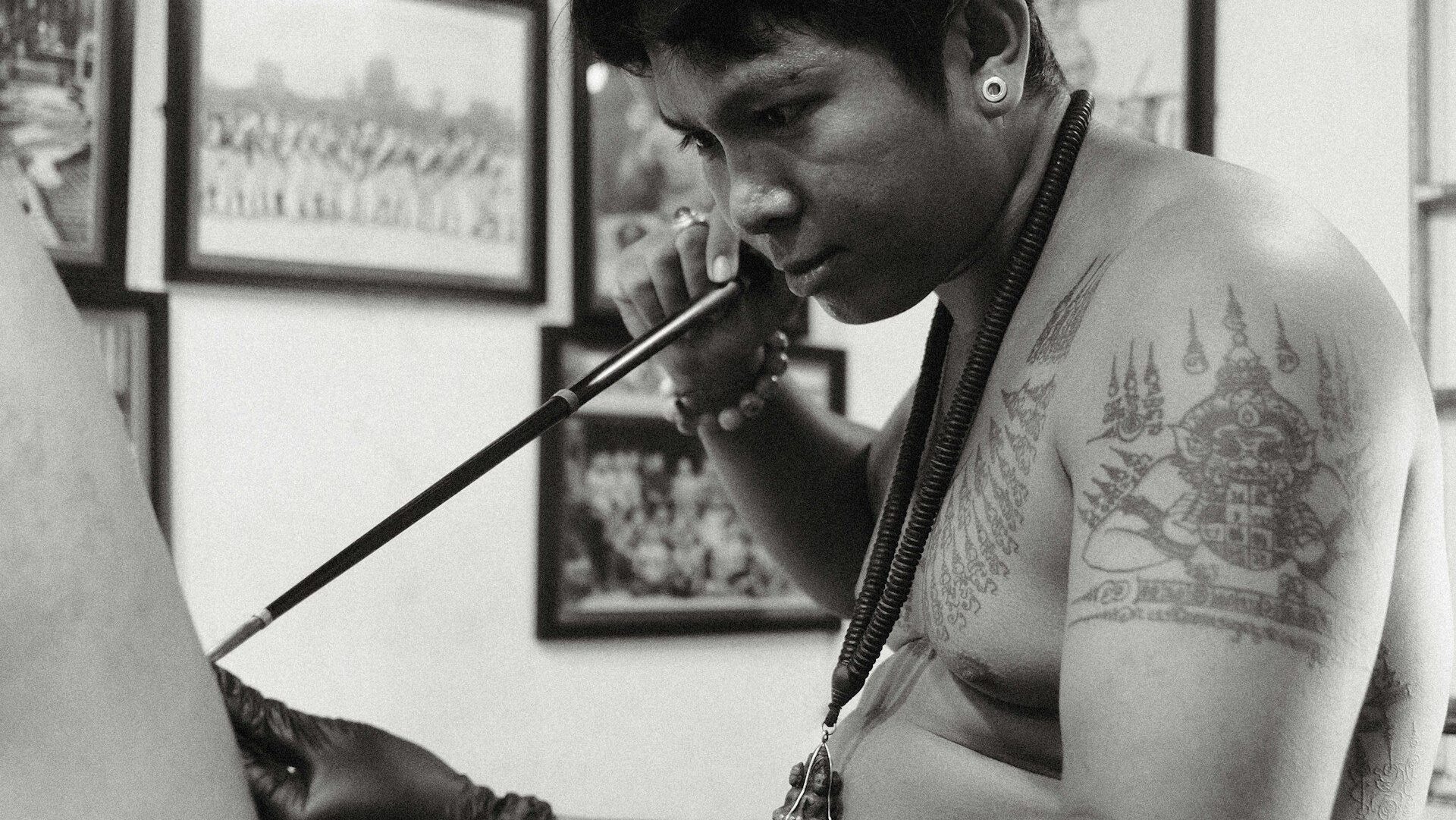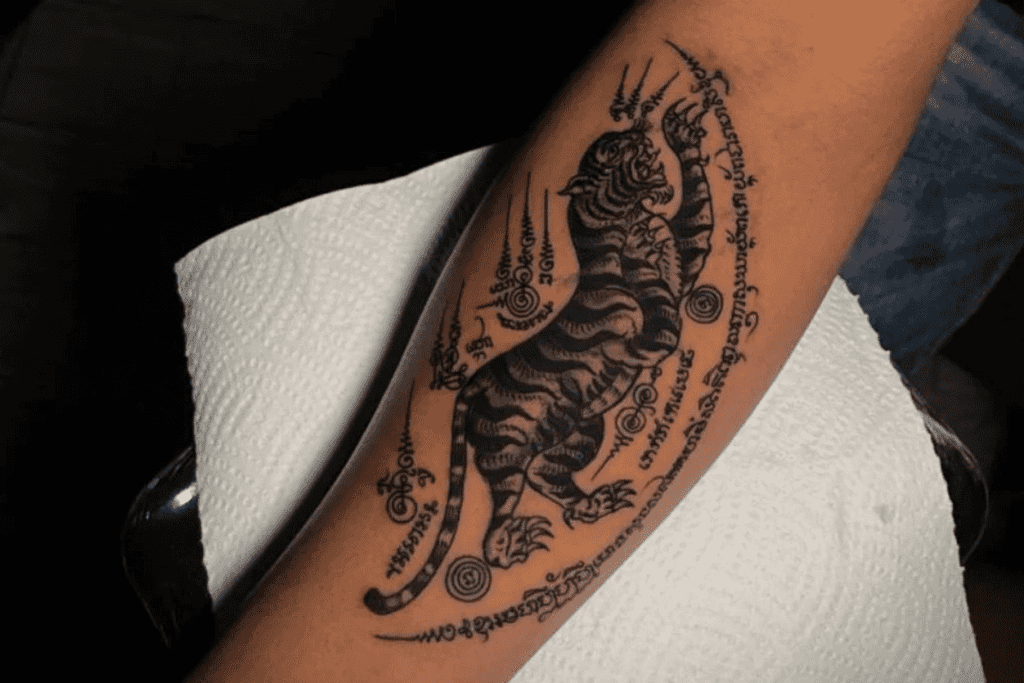
Tattoos in Cambodia have a rich history, blending ancient traditions with a rising contemporary culture. While tattoos have long held spiritual significance in Cambodian culture, a growing number of young people and travelers are also embracing tattoos as a form of self-expression.
Central to the traditional Cambodian tattoo culture is the mystical practice of Sak Yant, a form of tattooing believed to offer protection, strength, and blessings to the bearer. This practice, rooted in spirituality, magic, and folklore, is still cherished today, while new tattoo trends have also begun to shape Cambodia’s tattoo culture.
In this article, we’ll explore both the history and practice of Sak Yant tattoos in Cambodia and provide tips for travelers interested in the country’s tattoo culture.
What Is Sak Yant?
Sak Yant means “tattoo” (sak) and “sacred blessing” (yant, a derivation of “yantra”), referring to intricate tattoos often depicting deities, animals, or symbols with deep spiritual meanings. These tattoos are traditionally inked by a monk or kru (master) in a sacred ceremony where the tattoo is made using a long metal rod or bamboo needle.
In Cambodia, Sak Yant is closely related to the Khmer version of the practice, often tied to animist beliefs and practices introduced centuries ago by Khmer warriors who sought protection and strength for battle. Many Cambodians believe that Sak Yant tattoos are imbued with protective magic, especially if the tattooing process includes prayers, incantations, or blessings from a revered spiritual master.
The Symbolism and Types of Sak Yant Tattoos

Sak Yant tattoos are often complex designs with intricate lines, shapes, and symbols. Some common designs include:
- Hah Taew (Five Lines): Each line in this tattoo represents a protective prayer or incantation, meant to offer the bearer good luck, protection from harm, and success in life.
- Yant Gao Yord (Nine Peaks): Often placed at the base of the neck, the Nine Peaks design is believed to provide spiritual protection from negative influences and bad luck.
- Paed Tidt (Eight Directions): This tattoo, representing the eight directions, offers protection no matter where the bearer travels and is popular among people who travel frequently or who face dangerous situations.
- Hanuman (Monkey God): A famous figure in Cambodian mythology, Hanuman is often chosen for bravery, resilience, and loyalty. This tattoo is a symbol of strength and perseverance.
- Tiger Yant: Representing strength and power, the tiger Yant is especially popular among those seeking courage or fortitude.
- Buddha and Spiritual Symbols: Many Sak Yant tattoos incorporate Buddha imagery, spiritual symbols, or elements from sacred texts, offering both protection and a symbol of devotion.
The appeal of Sak Yant tattoos lies in their deep symbolism. For those who bear these tattoos, they are not merely decorative but carry a lifelong spiritual and emotional significance.
The Process of Getting a Sak Yant Tattoo
Getting a Sak Yant tattoo is not simply a transaction; it is a ceremonial experience. Typically, a Sak Yant tattoo is done in a temple or in the home of a Sak Yant master. Monks traditionally perform the ritual, and the entire process involves prayers, chanting, and a blessing that’s considered integral to the tattoo’s protective powers.
The tattooing process itself uses traditional hand-poking methods, which is a slower but highly precise technique. This method not only preserves the traditional Sak Yant style but is also believed to infuse the tattoo with its spiritual energy.
Note for Travelers: While non-Buddhist foreigners are generally welcomed to participate in Sak Yant ceremonies, it’s essential to understand and respect the practice. Some masters may refuse to ink certain symbols, like the Buddha, on foreigners, as this is considered sacred.
Modern Tattoo Culture in Cambodia
While Sak Yant represents Cambodia’s spiritual tattoo heritage, a modern tattoo scene has emerged in urban centers like Phnom Penh and Siem Reap. Today, Cambodian tattoo studios offer both traditional designs and contemporary styles like realism, geometric tattoos, and watercolor art. Cambodian tattoo artists are skilled in both hand-poked and machine tattoos, catering to locals and tourists alike who want a unique tattoo as a memento from their travels.
As tattoos become more widely accepted, young Cambodians are now opting for tattoos that reflect personal significance rather than traditional spiritual meanings. From small minimalist designs to large, intricate pieces, the variety and artistry in Cambodian tattoo studios reflect global tattoo trends.
Tips for Getting Tattoos in Cambodia
For travelers considering tattoos in Cambodia, here are a few tips:
- Research Studios Carefully: Find a reputable tattoo studio with certified artists. Phnom Penh and Siem Reap have a variety of well-established tattoo shops that offer quality services with good hygiene standards.
- Understand Sak Yant Etiquette: If you’re interested in a Sak Yant tattoo, make sure to learn about the cultural and spiritual significance. Consider visiting a temple or consulting with a kru who can explain the process and help you select a meaningful design.
- Respect Sacred Symbols: Many Cambodians view tattoos of the Buddha or other spiritual icons as deeply sacred, so it’s wise to discuss any design you’re considering with a knowledgeable local artist.
- Know Aftercare Practices: Cambodia’s tropical climate can affect healing, so follow proper aftercare instructions to prevent infection. Avoid swimming and exposure to direct sunlight, as these can impact the tattoo’s healing process.
Tattoos in Cambodia
Tattoo culture in Cambodia is a beautiful fusion of ancient spiritual practices and contemporary trends. Whether you’re drawn to the powerful symbols of Sak Yant or inspired by modern designs, Cambodia’s tattoo scene offers something for everyone. For those interested in the deeper, spiritual side of Cambodian tattoos, getting a Sak Yant tattoo can be a life-changing experience. Meanwhile, Cambodia’s emerging modern tattoo scene allows locals and visitors to leave with a memorable piece of body art that not only symbolizes their journey but serves as a lifelong reminder of Cambodia’s rich history and traditions.